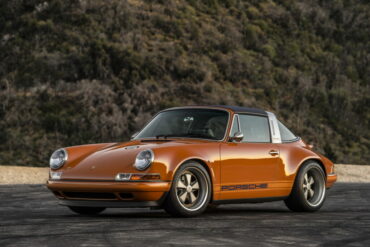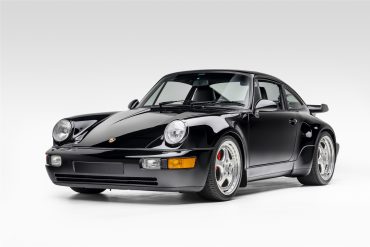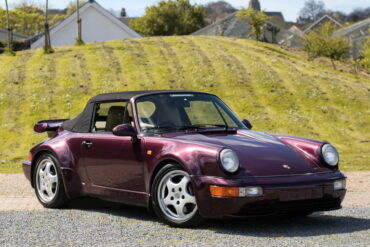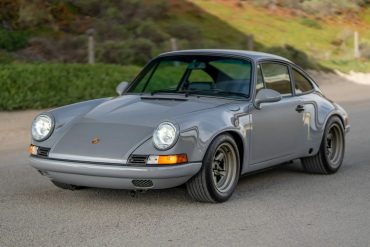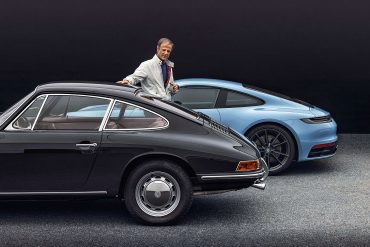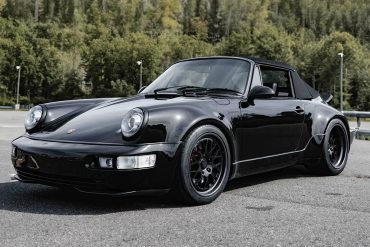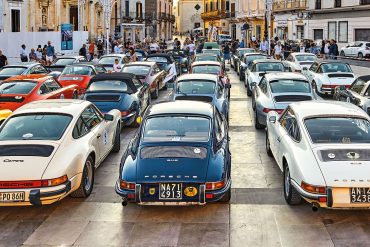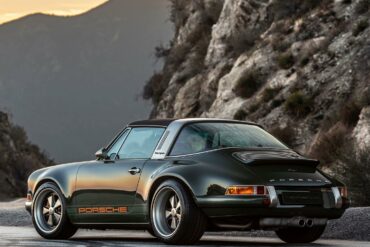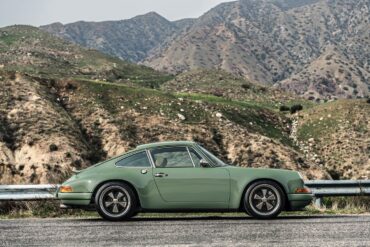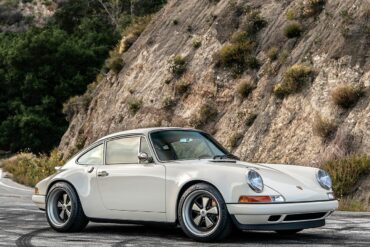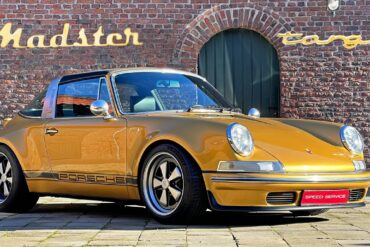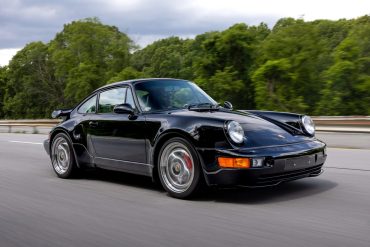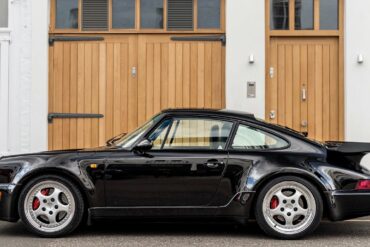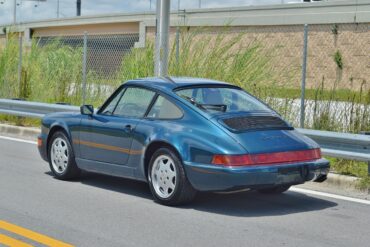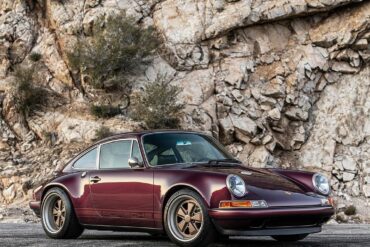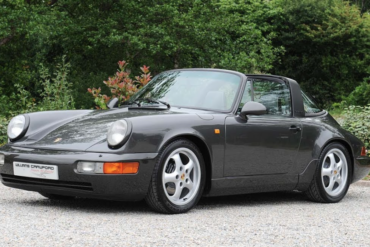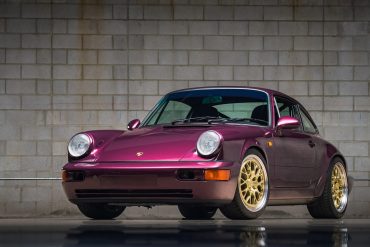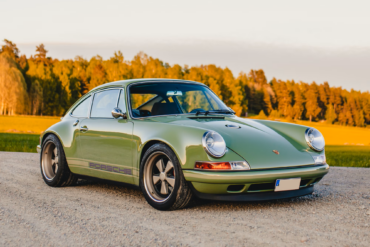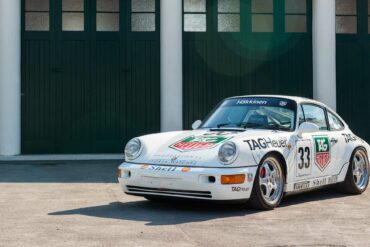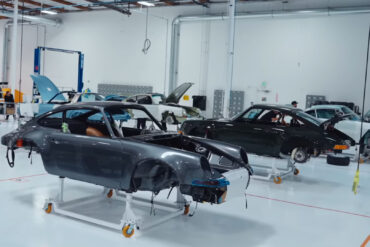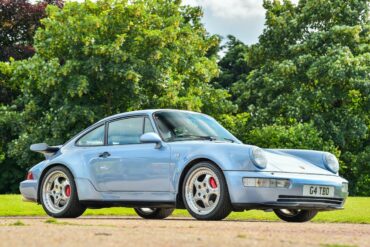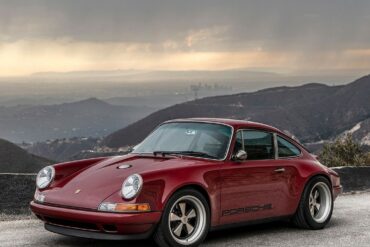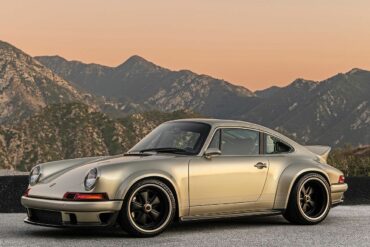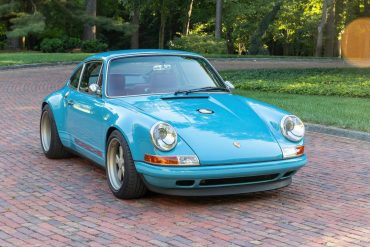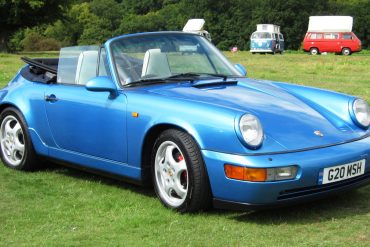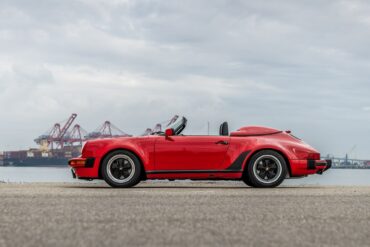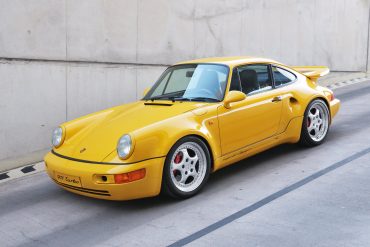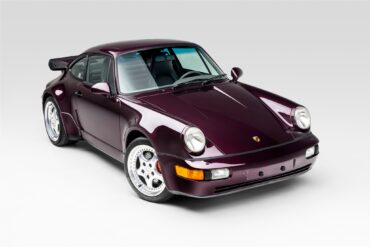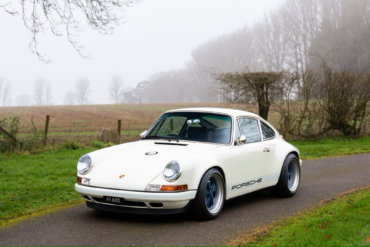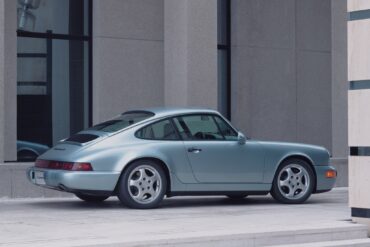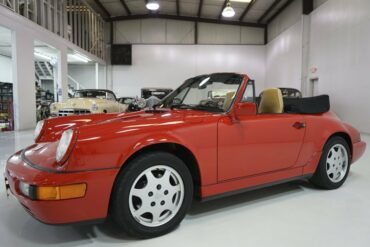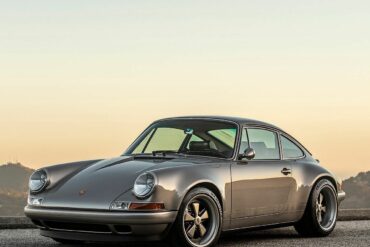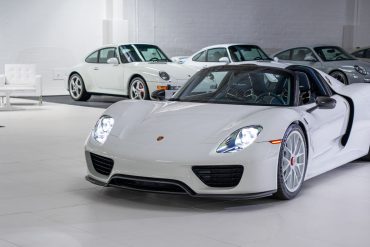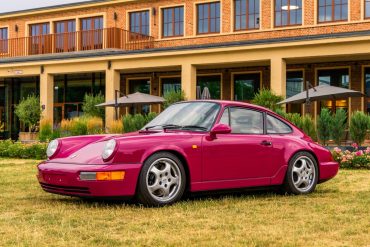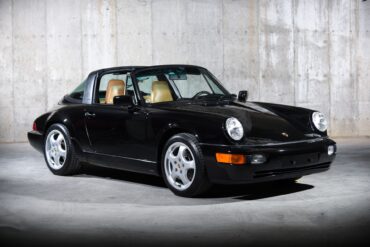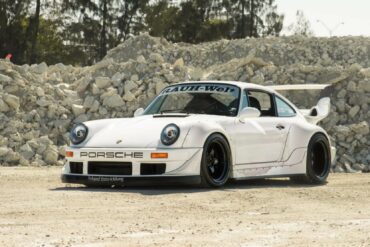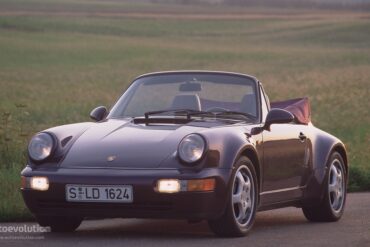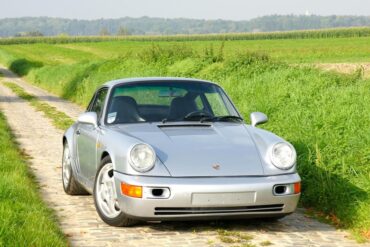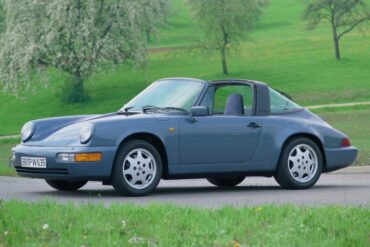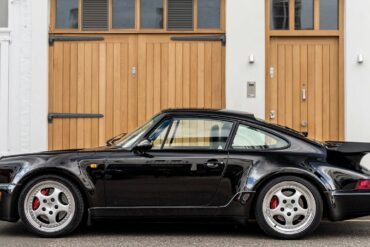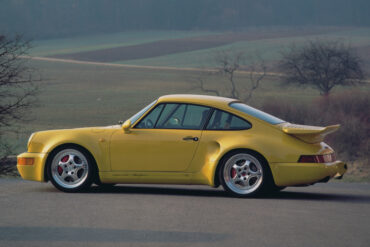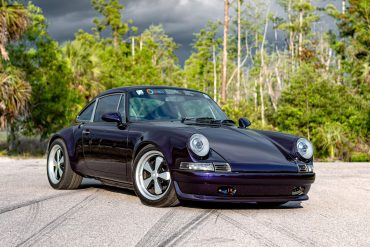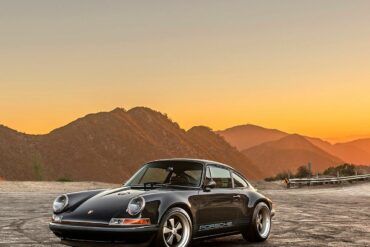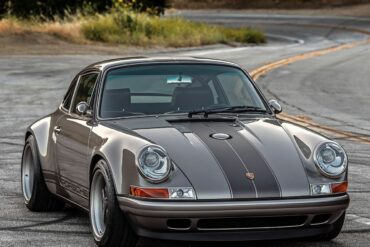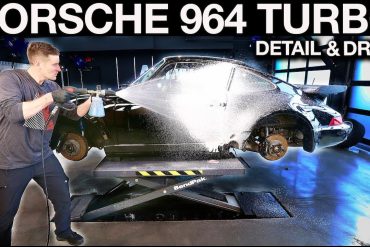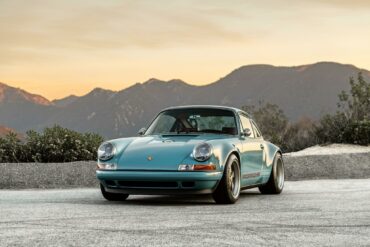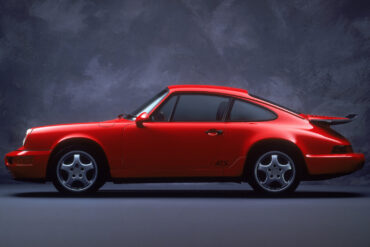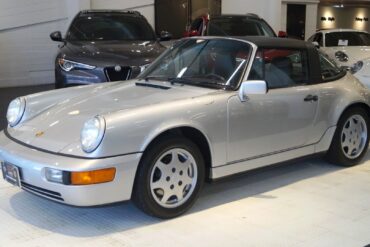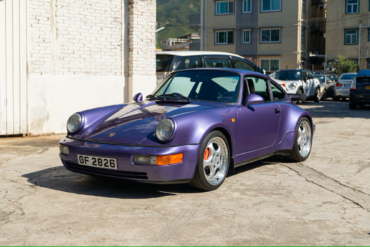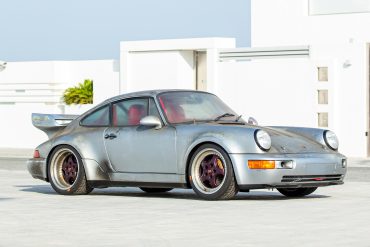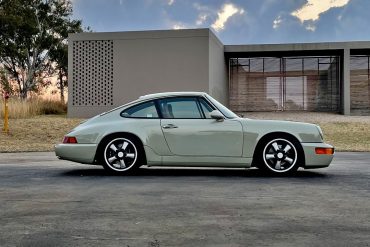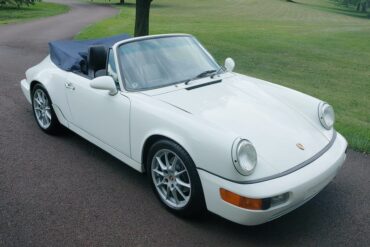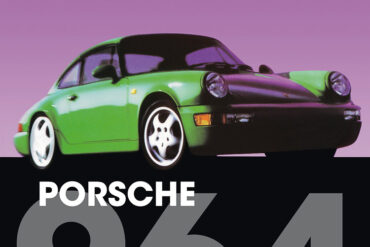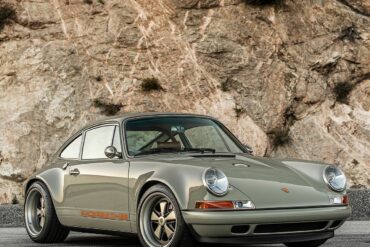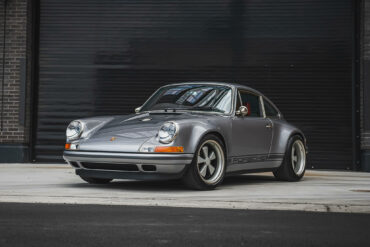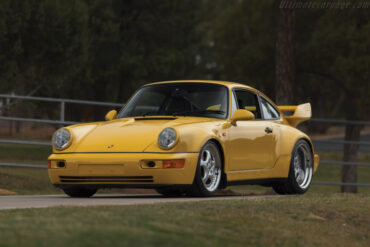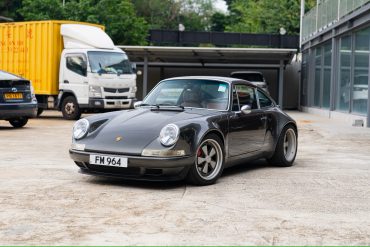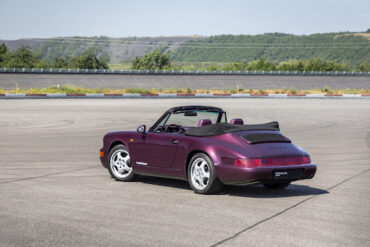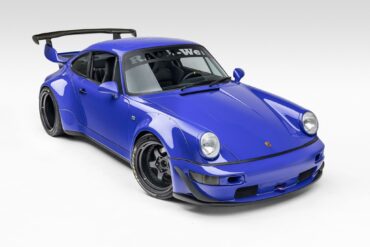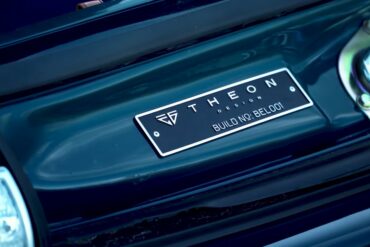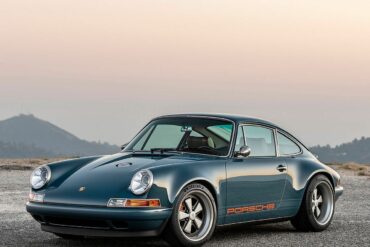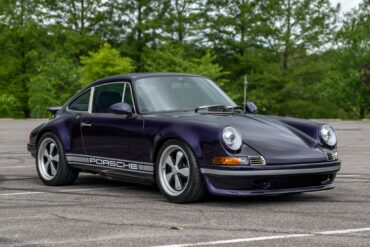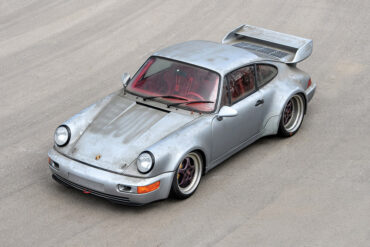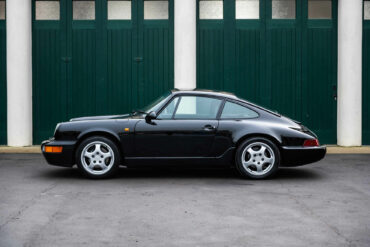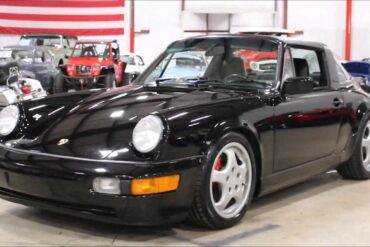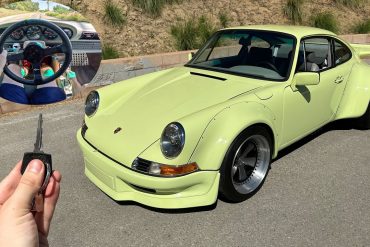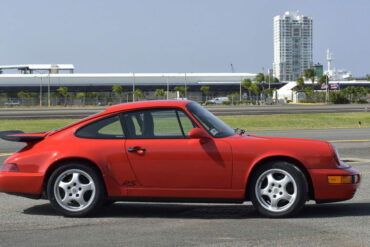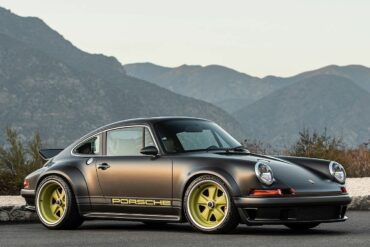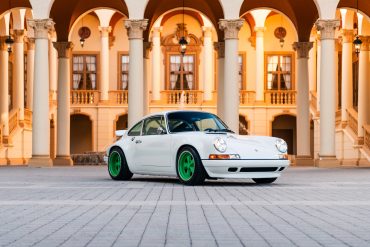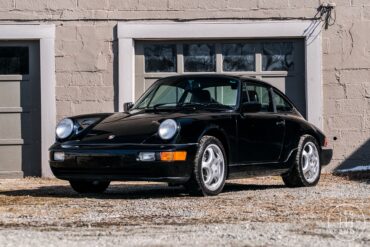Singer Vehicle Design – Luxemburg Commission Today, we take a closer look at the Singer Vehicle Designs Luxemburg Commission. The...
Porsche 911 (964)
In 1989 Porsche came out with the 911 Carrera 4 (964). The new 911 was a contemporary take on the classic two-door sports car and came at a time when many were predicting the end of the 911 (the company was producing the 944 and working on the upcoming 968). The long run of the previous 911 meant the 964 needed a major update and Porsche delivered on that promise with 85% new components and virtually none of the predecessor’s architecture used. Save for the introduction of aerodynamic polyurethane bumpers and an automatically-extending rear spoiler which replaced the “whale tail” found on the 911 throughout the 1980’s, externally, the 964 kept the same style as the classic 911. The 964 rode on a completely redesigned chassis with rear suspension switching from torsion bar to trailing arms with Porsche’s “Weissach” rear axle, which added self-steering elements to reduce the chance of oversteer. It featured a naturally aspirated 3.6 liter boxer engine that produced an impressive 250 horsepower. See all of our Porsche 964 Research.
In 1993, Porsche introduced the 911 Turbo 3.6, featuring an enhanced 3.6-liter single-turbo flat-six engine as a replacement for the...
Bid now to get the chance to acquire one of the rarest 964s ever built, a 1992 Porsche 911 Turbo...
In tribute to the iconic 1973 911 Carrera RS, Porsche applied a similar strategy to craft a lightweight version of...
The Turbo-look Porsche 964 has always been a very desirable automobile, among them 1,532 Carrera 2 Cabriolets constructed worldwide. Within that group, there were some cars that were even more specialized. The Register says six Turbo-look cabriolets were pulled off the production line in Zuffenhausen and transported to the Porsche Exclusive shop in Weissach. Three of these six powerful and luxuriously equipped drop-tops were equipped with left-hand drive for buyers in Germany (Code C00), and the other three were fitted with right-hand drive
This stunning 1989 Carrera 3.8L is a modified Porsche that has been “backdated” to incorporate classic 911 styling with modern...
Evolution, not Revolution Since its debut in 1964, the Porsche 911 has epitomized engineering evolution. Conceived by Ferdinand “Butzi” Porsche,...
For its inaugural venture, Sacrilege Motors meticulously refurbished and converted a Porsche 911 America Roadster to electric propulsion. This automobile...
“To hell with the timing. This is more important,” Wilfried Reinhardt says to himself. He hesitates for just a moment,...
Singer Vehicle Design – Glencoe Commission Today, we take a closer look at the Singer Vehicle Designs Glencoe Commission. This...
Singer Vehicle Design – Linden Green Commission Today, we take a closer look at the Singer Vehicle Designs Linden Green. Linden...
Singer Vehicle Design – Auburn Commission Today, we take a closer look at the Singer Vehicle Designs Auburn Commission. This...
Singer Vehicle Design has entered into a historic agreement with Porsche Motorsport North America. It is a partnership that will...
The folks at AutoTopNL managed to get their hands on a beautiful Porsche 964 Targa restomod built by Speed Service,...
This 1994 Porsche 911 Turbo S 3.6 Package is a stunning example of one of the 17 “Package” models produced...
How to Identify Your Porsche 911 (964) Turbo 3.6 In addition to the Slantnose cars there was a 964 Turbo...
1993 Porsche 911 Carrera 2 Coupe (964) Technical Specifications Engine Type Flat 6 Induction Normally-aspirated Cooling Air/oil-cooled Valvetrain Single overhead...
Porsche 911 (964) Transmission Codes The transmission number code is found on the transmission data plate. There were two codes...
The Berkshire Commission is a 4.0L, left-hand drive (LHD), rear-wheel-drive beauty presented in Amethyst Metallic with delicate ghosted stripes and...
1991 Porsche 911 Carrera 4 Targa (964) Technical Specifications Engine Type Flat 6 Induction Normally-aspirated Cooling Air/oil-cooled Valvetrain Single overhead...
Singer Vehicle Design – Kensington Commission Today, we take a closer look at the Singer Vehicle Designs Kensington Commission. First...
The 964 Carrera RS was introduced by Porsche for model year 1992 specifically for the European market as a lightweight,...
Singer Vehicle Design has established itself as one of the premier names in the world of custom Porsche 911s. The...
1994 Porsche 911 Turbo 3.6 S (964) Technical Specifications Engine Type Flat 6 Induction Turbocharged (K27 7006 Turbocharger) Cooling Air/oil-cooled...
964 Carrera Cup Champions & Results 964 Carrera Cup Germany 1990 Olaf Manthey Rüdiger Schmitt Wolfgang Land 1991 Roland Asch...
19 non 'slant nose' or Package cars were made for the USA only. Very rare. The Porsche factory had 93 Turbo chassis left. These were all transferred to Porsche Exclusiv and hand built as the very special 964 Turbo 3.6 S. They were offered with normal, or ‘Flachbau’ slant nose front ends. While the vast majority of Turbo S’ were fitted with the ‘Flachbau’ nose as a no-cost option, the Turbo S could also be had with the traditional 964 nose as well. In all, 76 Flatnose cars were made while 17 non-Flatnose (known as Package option) cars were made. These cars were also fitted with the X88 option, which increased power to 380 hp.
Background Perhaps no company has celebrated the heritage of the air-cooled 911 with such obsessive attention to detail as California-based...
1992 Porsche 911 Carrera 4 Coupe (964) Technical Specifications Engine Type Flat 6 Induction Normally-aspirated Cooling Air/oil-cooled Valvetrain Single overhead...
Singer has come a long way since its founder Rob Dickinson started turning Porsche 964s into four-wheeled jewelry 12 years...
Porsches are, by nature, expensive cars. Still, it’s hard not to notice when one sells for over a million dollars,...
Autosport Designs takes the Porsche 911/964 RS N/GT Clubsport for a test drive. One of only 290 examples produced and...
Porsche 911 (964) Paint Color Options This post outlines all the color options for the 964 generation Porsche 911 over...
Singer Vehicle Design – Berlin Commission Today, we take a closer look at the Singer Vehicle Designs Berlin Commission. This...
Singer Vehicle Design – Caroline Commission Today, we take a closer look at the Singer Vehicle Designs Caroline Commission. First...
Singer Vehicle Design is driven by the singular vision of Rob Dickinson, an ex-car designer and rock musician who came...
1990 Porsche 911 Carrera 2 Cabriolet (964) Technical Specifications Engine Type Flat 6 Induction Normally-aspirated Cooling Air/oil-cooled Valvetrain Single overhead...
The 1989 model of Porsche’s 911 Speedster model lineup is arguably one of the most recognizable as the 911 Speedster...
Retro Review of the 964 Turbo 3.6 Amazing performance numbers even for today. Equally amazing value retention....
It took Porsche twenty years before deciding to modernise its 911, yet outwardly, apart from its bumpers, the new 964...
Bring a Trailer is currently offering two very interesting Porsche 911s, a 1991 Porsche 911 Turbo and a low-mileage 1994...
This 1994 Porsche 911 belongs to a limited production run of around 1,500 Turbo 3.6 models manufactured during the 1993...
Dubbed “Newcastle Commission,” the car is based on a 964 Carrera 2. This 911 Reimagined by Singer also features the...
1990 Porsche 911 Carrera 4 Coupe (964) Technical Specifications Engine Type Flat 6 Induction Normally-aspirated Cooling Air/oil-cooled Valvetrain Single overhead...
Early Beginnings It all began in 1990 with the vehicles built for the Porsche Carrera Cup Deutschland. Since then, the...
1991 Porsche 911 Carrera 4 Cabriolet (964) Technical Specifications Engine Type Flat 6 Induction Normally-aspirated Cooling Air/oil-cooled Valvetrain Single overhead...
Sackey & Co. is proud to offer a stunning example of a 1993 Porsche 911 RS America finished in factory...
Singer Vehicle Design has emerged as arguably the foremost name in the realm of customizing Porsche 911s to date. Their...
Engine based on modified 3.6 litre 964 unit. Speedline wheels with big red brake calipers. Lessons learned in the Carrera Cup series proved the reliability of the new 3.6-litre engine. An additional three millimetres on the bore and two millimetres on the stroke, resulted in an increase in capacity of 300 cc. Combined with the turbo optimised cylinders, pistons and crank train, and an increase in the compression ratio from 7.0 to 7.5:1, this helped to boost power to 360 bhp. Torque was increased significantly to 520 Nm at 4200 rpm, up from 450 Nm at 4500 rpm in the earlier car.
Singer Vehicle Design – Canyon Drive Commission Today, we take a closer look at the Singer Vehicle Designs Canyon Drive...
You already read about our preview of The White Collection auction here on Stuttcars. Fifty-five Porsches, mostly in white, with...
In the early 1990s, Porsche focused on showcasing its new 964 Carreras globally in racing. The company developed track-ready versions...
Porsche Option Codes – Porsche 911 (1991 Model Year) Looking to decode your 1991 Porsche 911 option codes? Want to...
Akira Nakai, the renowned customizer behind RWB (Rauh-Welt Begriff) Porsches, is responsible for creating some of the world’s most iconic...
Porsche added the rear wheel drive Carrera 2 variant to the range in 1990. It was developed alongside the 964 Carrera 4, Porsche waited a year to release the Carrera 2 as a 1990 model year car. Like the Carrera 4, the Carrera 2 was available as a coupé, Targa or Cabriolet. Think of the cabriolet as a C2 coupe but with a fabric roof and more fun and you are right on the money. It was popular amongst buyers, particularly in the United States, with a total of 11,013 units sold, making it the third most popular 964 model.
Vintage Porsche 911s have garnered immense popularity in the restoration world, giving rise to businesses entirely dedicated to their reconstruction....
The original 1973 Carrera RS was available in Europe but not in the USA. Porsche decided to build the 1993 Carrera RS both to European spec and a limited number in compliance with US regulations. These US spec cars were assigned the name “RS America”. The intent was to create a basic lightweight, no frills 911 with minimal luxury options. The standard US Carrera 2 brakes, engine and gearbox were used. The RS weighed 2,945 pounds so it was almost 80 pounds lighter than a standard Carrera 2.
The 964 Carrera RS (Standard) was introduced by Porsche for model year 1992 specifically for the European market as a lightweight, high performance version of the 964 Carrera 2. It featured a revised version of the standard 3.6 liter engine, titled M64/03 internally, with an increased power output of 260 bhp (194 kW; 264 PS). The RS does not look much different from the other 911 models of the period but its weight is reduced and power increased. True to its racing spirit, the Carrera RS featured bucket seats and thinner materials, but lacked power windows, air conditioning, air bags, and other creature comforts.
Jenson Button’s Porsche 964 Turbo 3.6 For Sale The Porsche 911 Turbo 3.6 is a rare modern classic supercar, and...
1993 Porsche 911 Carrera 2 Targa (964) Technical Specifications Engine Type Flat 6 Induction Normally-aspirated Cooling Air/oil-cooled Valvetrain Single overhead...
1993 Porsche 911 Turbo 3.6 Coupe (964) Technical Specifications Engine Type Flat 6 Induction Turbocharged Cooling Air/oil-cooled Valvetrain Single overhead...
1993-1994 Porsche 911 Speedster (964) Technical Specifications Engine Type Flat 6 Induction Naturally Aspirated Cooling Air/oil-cooled Valvetrain Single overhead camshaft Injection...
Porsche made a lightweight version of the Turbo simply known as the Tuubo S. This used the spartan appointments of the Carrera RS with an upgraded version of the Turbo engine. Some cars received graphics on the side celebrating IMSA Supercar Championship. Similar to the Carrera RS, the Turbo S had no power steering, air conditioning, airbags, central locking, alarm system, rear window wiper, smaller window washer reservoir, smaller horn, and had thin-gauge glass. The engine used a second oil cooler and slightly higher boost to improve overall performance.
The unique restoration of this 1992 Porsche 964 Carrera 2 Coupe was exclusively commissioned to Olsen Motorsports, who carried out...
Singer Vehicle Design – Tatooine Commission Today, we take a closer look at the Singer Vehicle Designs Tatooine Commission. Like...
Singer Vehicle Design – Japan Commission Today, we take a closer look at the Singer Vehicle Designs Japan Commission. The...
Singer Vehicle Design – Fredericksburg Commission Today, we take a closer look at the Singer Vehicle Designs Fredericksburg Commission. The...
As somebody who owns a black 991.1 911 GTS, I can tell you that cleaning and maintaining black paint...
This is a Singer reimagined Porsche 911 called “Dartmouth Commission”. The car started as a 1989 Porsche 964 Carrera 4...
Porsche 911 (964) Technical Specifications & Model Comparison Comparison of the C2, RS, Cup 911 964s * shows how the...
1990 Porsche 911 Carrera 2 Targa (964) Technical Specifications Engine Type Flat 6 Induction Normally-aspirated Cooling Air/oil-cooled Valvetrain Single overhead...
At the Geneva Motor Show in March 1992, the 3.3-litre 964 Turbo S was unveiled sporting air inlet vents in...
Bonhams will auction one of the two existing examples of the Porsche 911 Carrera RSR 3.8-liter “Strassenversion” Coupé on November...
Singer Vehicle Design, founded in 2009 by former Catherine Wheel frontman Rob Dickinson and based in Los Angeles, specializes in...
On-board drive & in-depth review An on-board drive & in-depth review of the specs and build principles applied to our...
1991 Porsche 911 Carrera 2 Cabriolet (964) Technical Specifications Engine Type Flat 6 Induction Normally-aspirated Cooling Air/oil-cooled Valvetrain Single overhead...
In 1994, the standard Porsche Turbo 3.6 was the fastest production car available in the United States. The Turbo S...
Porsche 964: The Modern Classic by Paul Koebrugge – © Paul Koebrugge The history of Porsche sportscars is peppered with...
Singer Vehicle Design – Jersey Commission Today, we take a closer look at the Singer Vehicle Designs Jersey Commission. At...
Singer Vehicle Design – Le Mans Commission Today, we take a closer look at the Singer Vehicle Designs Le Mans...
Singer Vehicle Design – Oxford Commission Today, we take a closer look at the Singer Vehicle Designs Oxford Commission. The...
Singer Vehicle Design built the “Greenwich Commission” between 2017 and 2019 as their 109th project. This customized 911 is based...
The 964 Carrera RS 3.8 was produced as a base for homologation for the venerable 3.8 RSR. It was unveiled in 1993 and produced in a very small series by Porsche’s Racing Department in Weissach-Flacht, and was an extreme evolution of the 964 Carrera RS that was released two years prior. It featured the wide-body look of the Type 964 Turbo, a massive rear spoiler, and three-piece “Speedline for Porsche” wheels with 235/40 and 285/35 tires, making it distinctively more aggressive in appearance than the fairly restrained styling of the Carrera RS of 1992 and capable of providing significantly more mechanical grip.
Theon Design is rapidly establishing itself as a prominent figure in the realm of 911 restomods, specializing in the 964-generation...
1993 Porsche 911 Carrera 2 Cabriolet (964) Technical Specifications Engine Type Flat 6 Induction Normally-aspirated Cooling Air/oil-cooled Valvetrain Single overhead...
In January 2022, the current owner of this 1993 Porsche 964 Carrera 2 Coupe, originally delivered new in Japan, sent...
1994 Porsche 911 Carrera 4 Coupe (964) Technical Specifications Engine Type Flat 6 Induction Normally-aspirated Cooling Air/oil-cooled Valvetrain Single overhead...
Autocar reviews a 964-generation Porsche 911 which has been modified by Theon Design, a firm based in Oxfordshire. Find out...
Singer Vehicle Design – Michigan Commission Today, we take a closer look at the Singer Vehicle Designs Michigan Commission. This...
Strap in as Christian Gebhardt from sport auto pushes a Porsche 911 (964) Carrera RS to its limits around the...
Live now on PCARMARKET is a Canadian-market 1992 Porsche 964 Carrera 2 Coupe that was commissioned as a one-of-a-kind backdate...
Singer Vehicle Design – Westlake Commission Today, we take a closer look at the Singer Vehicle Designs Westlake Commission. The...
With the 1993 Carrera 2 as the starting point, Porsche had to make at least 50 roadgoing cars in order to qualify this new model for the Carrera ADAC GT Cup, which served as the basis for a motor racing variant to come, the Carrera RSR 3.8. The RSR 3.8 was nothing short of an all-out race car that could be delivered to the track in a ‘just add driver’ form. The Porsche Carrera RSR 3.8 racked up a catalogue of impressive international race results right from the outset, winning overall at the Spa 24 Hours, Suzuka 1000km, and the 24 Hours of Interlagos.
1992 Porsche 911 Carrera 2 Coupe (964) Technical Specifications Engine Type Flat 6 Induction Normally-aspirated Cooling Air/oil-cooled Valvetrain Single overhead...
1991 Porsche 911 Carrera 2 Targa (964) Technical Specifications Engine Type Flat 6 Induction Normally-aspirated Cooling Air/oil-cooled Valvetrain Single overhead...
Parker Nirenstein of the YouTube channel Vehicle Virgins gives us a first-person perspective of what it’s like to drive a...
1991-1992 Porsche 911 Carrera RS (964) Technical Specifications Engine Type Flat 6 Induction Naturally Aspirated Cooling Air/oil-cooled Valvetrain Single overhead...
In 1993, the 964 Turbo introduced an entirely new engine configuration to critical acclaim. The engine’s displacement was increased to...
Singer Vehicle Design – Naples Commission Today, we take a closer look at the Singer Vehicle Designs Naples Commission. This...
Established in Los Angeles in 2009, Singer Vehicle Design is a prominent figure in reimagining Porsche 911s from the 964-generation...
Porsche Option Codes – Porsche 911 (1990 Model Year) Looking to decode your 1990 Porsche 911 option codes? Want to...


